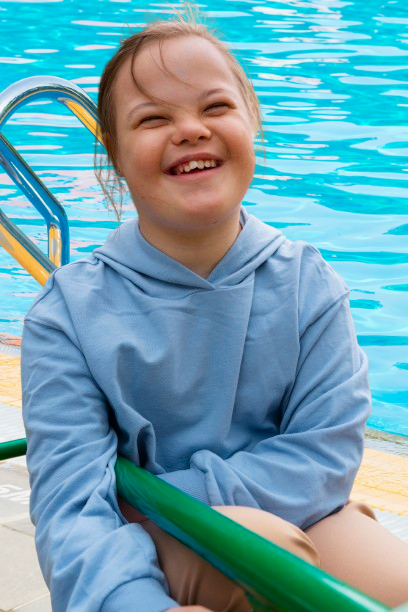Eficácia de Programa de Natação em Adolescentes com Síndrome de Down

Downloads
Palavras-chave:
programa de natação, capacidade aeróbica, força muscular, composição do corpo, Síndrome de DownResumo
O objetivo deste estudo foi estimar a influência de um programa de natação de 33 semanas na capacidade aeróbica, força muscular, equilíbrio, flexibilidade e composição corporal de adolescentes com síndrome de Down (SD). Vinte e dois adolescentes com diagnóstico de SD foram alocados aleatoriamente no grupo de treinamento (T) e no grupo de controle (C). O grupo T participou de 33 semanas de exercícios aquáticos e um programa de natação, enquanto o grupo de controle manteve suas atividades diárias normais. Após trinta e três semanas de programa de natação, a massa corporal, a gordura corporal e o IMC do grupo T diminuíram significativamente (de 56,8 ± 7,97 kg para 55,0 ± 7,11 kg, de 15,1 ± 4,47 kg para 13,2 ± 3,92 kg e de 25,1 ± 4,47 kg para 13,2 ± 3,92 kg). 2,37 para 24,0 ± 2,05, respectivamente), enquanto um aumento significativo foi registrado em C (de 57,3 ± 8,43 kg para 59,7 ± 8,29 kg, de 14,5 ± 2,76 kg para 16,0 ± 3,11 kg, e de 25,4 ± 2,46 para 26,0 ± 2,72, respectivamente ). Além disso, foi observada melhora significativa na capacidade aeróbica no grupo T; O VO2máx (mL/kg/min) aumentou 16,3% em T e diminuiu 4,8% em C. Observou-se melhora na força estática de braço, força de tronco e resistência/força funcional em T, enquanto os parâmetros não se alteraram em C. A velocidade do movimento do braço, o equilíbrio e a flexibilidade não mudaram após a intervenção. Além disso, as habilidades aquáticas melhoraram significativamente no grupo de treino. Mudanças em C não foram significativas. Os resultados do nosso estudo indicam que o programa de natação de 33 semanas melhorou significativamente o estado de saúde e as habilidades de natação em adolescentes com SD.
Referências
(1) Bertapelli, F.; Pitetti, K.; Agiovlasitis, S.; Guerra-Junior, G. Overweight and obesity in children and adolescents with Down syndrome-prevalence, determinants, consequences, and interventions: A literature review. Res. Dev. Disabil. 2016, 57, 181–192.
(2) World Health Organization. Global Health Risks Mortality and Burden of Disease Attributable to Selected Major Risks; WHO Library Cataloguing-in-Publication Data; World Health Organization: Geneva, Switzerland, 2009; pp. 1–62.
(3) Vis, J.C.; Duffels, M.G.J.; Winter, M.M.; Weijerman, M.E.; Cobben, J.M.; Huisman, S.A.; Mulder, B.J.M. Down syndrome: A cardiovascular perspective. J. Intellect. Disabil. Res. 2009, 53, 419–425.
(4) Heller, T.; Hsieh, K.; Rimmer, J. Barriers and support for exercise participation among adults with Down syndrome. J. Gerontol. Soc. Work 2008, 38, 161–178.
(5) Castro-Piñero, J.; Carbonell-Baeza, A.; Martinez-Gomez, D.; Gómez-Martínez, S.; Cabanas-Sánchez, V.; Santiago, C.; Veses, A.N.; Bandrés, F.; Gonzalez-Galo, A.; Gomez-Gallego, F.; et al. Follow-up in healthyschoolchildren and in adolescents with DOWN syndrome: Psycho-environmental and genetic determinants of physical activity andits impact on fitness, cardiovascular diseases, inflammatory biomarkersand mental health; the UP&DOWN Study. BMC Public Health 2014, 14, 400.
(6) Fernhall, B.; McCubbin, J.A.; Pitetti, K.H.; Rintala, P.; Rimmer, J.H.; Millar, A.L.; De Silva, A. Prediction of maximal heart rate in individuals with mental retardation. J. Sci. Med. Sports 2001, 33, 1655–1660.
(7) Wee, S.O.; Pitetti, K.H.; Goulopoulou, S.; Collier, S.R.; Guerra, M.; Baynard, M. Impact of obesity and Down syndrome on peak heart rate and aerobic capacity in youth and adults. Res. Dev. Disabil. 2015, 36C, 198–206.
(8) Hayden, M.F. Mortality among people with mental retardation living in the united states: Research review and policy application. Ment. Retard. 1998, 36, 345–359.
(9) Izquierdo-Gomez, R.; Martinez-Gomez, D.; Villagra, A.; Fernhall, B.; Veiga, O.L. Associations of physical activity with fatness and fitness in adolescents with Down syndrome: The UP & DOWN study. Res. Dev. Disabil. 2015, 36, 428–436.
(10) Pitetti, K.; Baynard, T.; Agiovlasitis, S. Children and adolescents with Down syndrome, physical fitness and physical activity. J. Sports Health. Sci. 2013, 2, 47–57.
(11) DHSC. UK Chief Medical Officers Physical Activity Guidelines; Department of Health and Social Care: London, UK, 2019; pp. 1–65.
(12) Guthold, R.; Stevens, G.A.; Riley, L.M.; Bull, F.C. Global Trends in Insufficient Physical Activity among Adolescents: A Pooled Analysis of 298 Population-Based Surveys with 16 Million Participants. Lancet Child Adolesc. Health 2020, 4, 23–35.
(13) Shields, N.; Plant, S.; Warren, C.; Wollersheim, D.; Peiris, C. Do adults with Down syndrome do the same amount of physical activity as adults without disability? A proof of principle study. J. Appl. Res. Intellect. Disabil. 2018, 31, 459–465.
(14) Seron, B.B.; Modesto, E.L.; Stanganelli, L.C.R.; Oliveira de Carvalho, E.M.; Greguol, M. Effects of aerobic and resistance training on the cardiorespiratory fitness of young people with Down Syndrome. Rev. Bras. Cineantropom. Hum. 2017, 19, 385–394.
(15) Paul, Y.; Ellapen, T.J.; Barnard, M.; Hammill, H.V.; Swanepoel, M. The health benefits of exercise therapy for patients with Down syndrome: A systematic review. Afr. J. Disabil. 2019, 8, a576.
(16) Ilinca, I.; Roșulescu, E.; Cosma, G.; Danoiu, M. The influence of physiotherapy on functional fitness of adults with down syndrome. Phys. Ed. Sport Kin. J. 2019, 97–100.
(17) Millar, A.L.; Fernhall, B.; Burkett, L.N. Effects of aerobic training in adolescents with Down syndrome. Med. Sci. Sports Exerc. 1993, 25, 270–274.
(18) Pérez, C.A.; Carral, J.M.C.; Costas, A.A.; Martínez, S.V.; Martínez-Lemos, R.I. Water-based exercise for adults with Down syndrome: Findings from a preliminary study. Int. J. Ther. Rehabil. 2018, 25, 20–28.
(19) Suarez-Villadat, B.; Veiga, O.L.; Villagraa, A.Z.; Izquierdo-Gomez, R.P.; UP&DOWN Study Group. Changes in Body Composition and Physical Fitness in Adolescents with Down Syndrome: The UP&DOWN Longitudinal Study. Child. Obes. 2019, 15, 397–405.
(20) MacDonncha, C.; Watson, A.S.; McSweeney, T.; O’Donovan, D. Reliability of Eurofit physical items for adolescent males with and without mental retardation. Adapt. Phys. Act. Q. 1999, 16, 86–95.
(21) Baynard, T.; Pitetti, K.H.; Guerra, M.; Unnithan, V.B.; Fernhall, B. Age-Related Changes in Aerobic Capacityin Individuals with Mental Retardation: A 20-yr Review. Med. Sci. Sports Exerc. 2008, 40, 1984–1989.
(22) Fernhall, B.; Pitetti, K.H.; Rimmer, J.H.; McCubbin, J.A.; Rintala, P.; Millar, A.L.; Kittredge, J.; Burkett, L.N. Cardiorespiratory capacity of individuals with mental retardation including Down syndrome. Med. Sci. Sports Exerc. 1996, 28, 366–371.
(23) The American Academy for Cerebral Palsy and Developmental Medicine. Available online: https://www.aacpdm.org/UserFiles/file/BRK9c_Tirosh.pdf (accessed on 6 July 2021).
(24) Tirosh, R.; Katz-Leurer, M.; Getz, M.D. Halliwick-Based Aquatic Assessments: Reliability and Validity. Int. J. Aquat. Res. Educ. 2008, 3, 1–13.
(25) Cohen, J. Statistical Power Analysis for the Behavioral Sciences, 2nd ed.; Lawrence Erlbaum Associates: New York, NY, USA, 1988.
(26) González-Agüero, A.; Ara, I.; Moreno, L.A.; Vicente-Rodríguez, G.; Casajús, J.A. Fat and lean masses in youths with Down syndrome: Gender differences. Res. Dev. Disabil. 2011, 33, 1685–1693.
(27) Murray, J.; Ryan-Krause, P. Obesity in children with down syndrome: Background and recommendations for management. Pediatr. Nurs. 2010, 36, 314–319.
(28) O’Shea, M.; O’Shea, C.; Gibson, L.; Leo, J.; Carty, C. The prevalence of obesity in children and young people with Down syndrome. J. Appl. Res. Intellect. Disabil. 2018, 31, 1225–1229.
(29) Maffeis, C.; Tato, L. Long-term effects of childhood obesity on morbidity and mortality. Horm. Res. 2001, 55 (Suppl. 1), 42–45.
(30) Suarez-Villadat, B.; Luna-Olivac, L.; Acebesa, C.; Villagraa, A. The effect of swimming program on body composition levels in adolescents with Down syndrome. Res. Dev. Disabil. 2020, 102, 1–8.
(31) Farías-Valenzuela, C.; Cofré-Bolados, C.; Ferrari, G.; Espoz-Lazo, S.; Arenas-Sánchez, G.; Álvarez-Arangua, S.; Espinoza-Salinas, A.; Valdivia-Moral, P. Effects of Motor-Games-Based Concurrent Training Program on Body Composition Indicators of Chilean Adults with Down Syndrome. Sustainability 2021, 13, 5737.
(32) González-Agüero, A.; Vicente-Rodríguez, G.; Gómez-Cabello, A.; Ara, I.; Moreno, L.A.; Casajús, J.A. A combined training intervention programme increases lean mass in youths with Down syndrome. Res. Dev. Disabil. 2011, 32, 2383–2388.
(33) Paffenbarger, R.S.; Blair, S.N.; Lee, I.M. A history of physical activity, cardiovascular health and longevity: The scientific cbcontributions of Jeremy N Morris, DSc, DPH, FRCP. Int. J. Epidemiol. 2001, 30, 1184–1192.
(34) González-Agüero, A.; Vicente-Rodriguez, G.; Moreno, L.A.; Guerra-Balic, M.; Ara, I.; Casajus, J.A. Health-related physical fitness in children and adolescents with Down syndrome and response to training. Scand. J. Med. Sci. Sports 2010, 20, 716–724.
(35) Savucu, Y. Influence of 12-Week Training on Aerobic Capacity and Respiratory Functions of Adolescents with down Syndrome. World Appl. Sci. J. 2010, 11, 1292–1296.
(36) Lewis, C.L.; Fragala-Pinkham, M.A. Effects of aerobic conditioning and strength training on a child with Down syndrome: A case study. Pediatr. Phys. Ther. 2005, 17, 30–36.
(37) Silva, V.; Campos, C.; Sá, A.; Cavadas, M.; Pinto, J.; Simões, P.; Machado, S.; Murillo-Rodríguez, E.; Barbosa-Rocha, N. Wii-based exercise program to improve physical fitness, motor proficiency and functional mobility in adults with Down syndrome. J. Intellectx. Disabil. Res. 2017, 61, 755–765.
(38) Parab, S.; Bose, M.; Shayer, S.; Saini, R.K.; Salvi, M.; Ravi, P.; Sawant, P. Bharatnatyam-based dance therapy in Children and and Adolescents with Down Syndrome. Clin. Kinesiol. 2019, 73, 15–20.
(39) Varela, A.M.; Sardinha, L.B.; Pitetti, K.H. Effects of an aerobic rowing training regimen in young adults with Down syndrome. Am. J. Ment. Retard. 2001, 106, 135–144.
(40) Çiğdem, E.; Hüzmeli, E.D.; Gökçek, Ö. Investigation of the Relationship between Physical Activity and Body Mass Index in Children with Down Syndrome. J. Pediatr. Res. 2020, 7, 92–96.
(41) Vaščáková, T.; Kudláček, M. Halliwick Concept of Swimming and its Influence on Motoric Competencies of Children with Severe Disabilities. Eur. J. Adapt. Phys. Act. 2015, 8, 44–49.
(42) Declerck, M.; Verheul, M.; Daly, D.; Sanders, R. Benefits and Enjoyment of a Swimming Intervention for Youth with Cerebral Palsy: An RCT Study. Pediatr. Phys. Ther. 2016, 28, 162–169.
_________________________________
Artigo adaptado e traduzido para o português pelos editores de NADAR! SWIMMING MAGAZINE para republicação, conforme normas de submissão do periódico. Versão original em: https://www.mdpi.com/1660-4601/18/14/7441 LICENÇA ORIGINAL E DA ADAPTAÇÃO: © 2021 by the authors. https://creativecommons.org/licenses/by/4.0/.
Imagem ilustrativa. Fonte: Image by pikisuperstar on Freepik - Image by mrsiraphol on Freepik
Publicado
Como Citar
Edição
Seção
ARK
Licença
Copyright (c) 2024 Alicja Naczk, Ewa Gajewska, Mariusz Naczk

Este trabalho está licenciado sob uma licença Creative Commons Attribution 4.0 International License.






